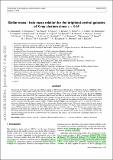Stellar mass-halo mass relation for the brightest central galaxies of X-ray clusters since z~0.65
Abstract
We present the brightest cluster galaxies (BCGs) catalog for SPectroscoic IDentification of eROSITA Sources (SPIDERS) DR14 cluster program value-added catalog. We list the 416 BCGs identified as part of this process, along with their stellar mass, star formation rates, and morphological properties. We identified the BCGs based on the available spectroscopic data from SPIDERS and photometric data from SDSS. We computed stellar masses and SFRs of the BCGs on the basis of SDSS, WISE, and GALEX photometry using spectral energy distribution fitting. Morphological properties for all BCGs were derived by Sersic profile fitting using the software package SIGMA in different optical bands (g,r,i). We combined this catalog with the BCGs of galaxy groups and clusters extracted from the deeper AEGIS, CDFS, COSMOS, XMM-CFHTLS, and XMM-XXL surveys to study the stellar mass - halo mass relation using the largest sample of X-ray groups and clusters known to date. This result suggests that the mass growth of the central galaxy is controlled by the hierarchical mass growth of the host halo. We find a strong correlation between the stellar mass of BCGs and the mass of their host halos. This relation shows no evolution since z ∼ 0.65. We measure a mean scatter of 0.21 and 0.25 for the stellar mass of BCGs in a given halo mass at low (0.1<z<0.3) and high (0.3<z<0.65) redshifts, respectively. We further demonstrate that the BCG mass is covariant with the richness of the host halos in the very X-ray luminous systems. We also find evidence that part of the scatter between X-ray luminosity and richness can be reduced by considering stellar mass as an additional variable.
Citation
Erfanianfar , G , Finoguenov , A , Furnell , K , Popesso , P , Biviano , A , Wuyts , S , Collins , C A , Mirkazemi , M , Comparat , J , Khosrashahi , H , Nandra , K , Capasso , R , Rykoff , E , Wilman , D , Merloni , A , Clerc , N , Salvato , M , Chitham , J I , Gozaliasl , G , Weijmans , A , Brownstein , J , Egami , E , Pereira , M J , Schneider , D P , Kirkpatrick , C , Damsted , S & Kukkola , A 2019 , ' Stellar mass-halo mass relation for the brightest central galaxies of X-ray clusters since z~0.65 ' , Astronomy & Astrophysics , vol. 631 , A175 . https://doi.org/10.1051/0004-6361/201935375
Publication
Astronomy & Astrophysics
Status
Peer reviewed
ISSN
0004-6361Type
Journal article
Collections
Items in the St Andrews Research Repository are protected by copyright, with all rights reserved, unless otherwise indicated.
Related items
Showing items related by title, author, creator and subject.
-
SDSS-IV MaNGA: How the stellar populations of passive central galaxies depend on stellar and halo mass
Oyarzún, Grecco A.; Bundy, Kevin; Westfall, Kyle B.; Tinker, Jeremy L.; Belfiore, Francesco; Argudo-Fernández, Maria; Zheng, Zheng; Conroy, Charlie; Masters, Karen L.; Wake, David; Law, David R.; McDermid, Richard M.; Aragón-Salamanca, Alfonso; Parikh, Taniya; Yan, Renbin; Bershady, Matthew; Sánchez, Sebastián F.; Andrews, Brett H.; Fernández-Trincado, José G.; Lane, Richard R.; Bizyaev, D.; Boardman, Nicholas Fraser; Lacerna, Ivan; Brownstein, J. R.; Drory, Niv; Zhang, Kai (2022-07-06) - Journal articleWe analyze spatially resolved and co-added SDSS-IV MaNGA spectra with signal-to-noise ratio ∼100 from 2200 passive central galaxies (z ∼ 0.05) to understand how central galaxy assembly depends on stellar mass (M*) and halo ... -
Secular-and merger-built bulges in barred galaxies
Mendez Abreu, Jairo; Debattista, V. P.; Corsini, E. M.; Aguerri, J. A. L. (2014-12) - Journal articleContext. Historically, galaxy bulges were thought to be single-component objects at the center of galaxies. However, this picture is now questioned since different bulge types with different formation paths, namely classical ... -
Galaxy And Mass Assembly (GAMA) : galaxy close pairs, mergers and the future fate of stellar mass
Robotham, A. S. G.; Driver, S. P.; Davies, L. J. M.; Hopkins, A. M.; Baldry, I. K.; Agius, N. K.; Bauer, A. E.; Bland-Hawthorn, J.; Brough, S.; Brown, M. J. I.; Cluver, M.; De Propris, R.; Drinkwater, M. J.; Holwerda, B. W.; Kelvin, L. S.; Lara-Lopez, M. A.; Liske, J.; Lopez-Sanchez, A. R.; Loveday, J.; Mahajan, S.; McNaught-Roberts, T.; Moffett, A.; Norberg, P.; Obreschkow, D.; Owers, M. S.; Penny, S. J.; Pimbblet, K.; Prescott, M.; Taylor, E. N.; van Kampen, E.; Wilkins, S. M. (2014-11-11) - Journal articleWe use a highly complete subset of the Galaxy And Mass Assembly II (GAMA-II) redshift sample to fully describe the stellar mass dependence of close pairs and mergers between 10(8) and 10(12)M(circle dot). Using the analytic ...

